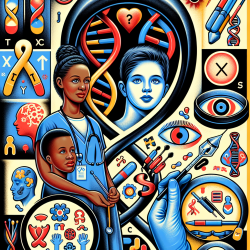Autism Spectrum Disorder (ASD) is a complex neurodevelopmental condition characterized by challenges in social interaction, communication, and repetitive behaviors. Recent research has shed light on the embryonic origins of ASD, particularly focusing on the size of brain cortical organoids (BCOs) and their correlation with social symptom severity. This blog post will explore these findings and discuss how practitioners can apply this knowledge to improve their skills and encourage further research.
The Research: Embryonic Origins of ASD Subtypes
The study titled "Embryonic origin of two ASD subtypes of social symptom severity: the larger the brain cortical organoid size, the more severe the social symptoms" highlights significant findings in the field of autism research. Conducted by Dr. Eric Courchesne and his team at the University of California San Diego, the study investigates how early brain overgrowth during embryogenesis can predict the severity of social symptoms in toddlers with ASD.
The researchers measured BCO size in 10 toddlers with ASD and compared it to 6 control subjects. They found that larger BCO sizes were significantly correlated with more severe social symptoms. This correlation was consistent across two independent batches conducted in 2021 and 2022. The study identified two distinct subtypes of ASD based on BCO size: one with profound autism characterized by severe social symptoms and another with milder symptoms.
Implications for Practitioners
For practitioners working with individuals with ASD, these findings offer valuable insights into the biological underpinnings of the disorder. Understanding that ASD begins as early as embryogenesis emphasizes the importance of early diagnosis and intervention. Practitioners can use this knowledge to tailor their therapeutic approaches based on the subtype of ASD identified in their patients.
- Early Diagnosis: By recognizing signs of early brain overgrowth, practitioners can identify children at risk for severe ASD symptoms sooner, allowing for timely intervention.
- Customized Interventions: Treatments can be more effectively tailored to address specific biological subtypes, potentially improving outcomes for individuals with profound or mild autism.
- Encouraging Further Research: Practitioners are encouraged to engage in or support further research that explores prenatal origins of ASD and potential interventions targeting embryonic development stages.
The Path Forward: Research and Collaboration
The study underscores the need for continued research into the prenatal origins of ASD. Larger sample sizes and comprehensive molecular studies could reveal additional subtypes and inform more precise treatment strategies. Collaboration between researchers, clinicians, and educators is crucial to advancing our understanding of ASD and improving outcomes for individuals affected by this disorder.
To read the original research paper, please follow this link: Embryonic origin of two ASD subtypes of social symptom severity: the larger the brain cortical organoid size, the more severe the social symptoms.










